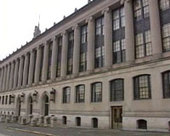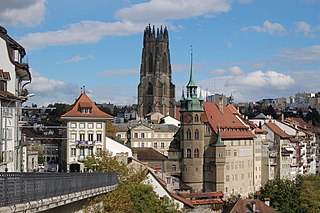
Michael O'Connor, S.J., was an Irish-born prelate of the Roman Catholic Church in the United States and a member of the Society of Jesus. He served as the Bishop of Pittsburgh and briefly as the Bishop of Erie (1853).

James Augustine Healy was an American Roman Catholic priest and the second bishop of Portland, Maine; he was the first bishop in the United States of any known African descent. Born in Georgia to a mixed-race slave mother and Irish immigrant father, he identified and was accepted as white Irish American, as he was half Irish and majority European ancestry. When he was ordained in 1854, his mixed-race ancestry was not widely known outside his mentors in the Catholic Church.

Peter Canisius, S.J. was a renowned Dutch Jesuit Catholic priest. He became known for his strong support for the Catholic faith during the Protestant Reformation in Germany, Austria, Bohemia, Moravia, Switzerland and the United Kingdom. The restoration of the Catholic Church in Germany after the Protestant Reformation is largely attributed to the work there of the Society of Jesus, which he led. He is venerated in the Catholic Church as a saint and as a Doctor of the Church.

Very Rev. Jan Philipp Roothaan, S.J. was a Dutch Jesuit, elected twenty-first Superior-General of the Society of Jesus.

Very Rev. Anton Maria Anderledy, S.J., was a Swiss Jesuit, elected the twenty-third Superior General of the Society of Jesus.
John Bernard Fitzpatrick was an American bishop of the Roman Catholic Church. He served as Bishop of Boston from 1846 until his death in 1866.

Benedict Joseph Fenwick was an American bishop of the Catholic Church. A Jesuit, he served as Bishop of Boston from 1825 until his death in 1846.
John Gerard was an English Jesuit priest, operating covertly in England during the Elizabethan era in which the Catholic Church was subject to persecution. He was the second son of Sir Thomas Gerard of Bryn, in Ashton-in-Makerfield, Lancashire.
Saint Thomas Garnet was a Jesuit priest who was executed in London. He is the protomartyr of Saint Omer and therefore of Stonyhurst College. He was executed at Tyburn and is one of the Forty Martyrs of England and Wales.
The English College, was a Catholic seminary in Douai, now in France, associated with the University of Douai. It was established in about 1561, and was suppressed in 1793. It is known for a Bible translation referred to as the Douay–Rheims Bible. Of over 300 priests from Douai sent on the English mission, about one-third were executed. The dissolution of the college at the tie of the French Revolution led to the founding of Crook Hall and St Edmund's College, Ware. It is popularly believed that the indemnification funds paid by the French for the seizure of Douai's property were diverted by the British commissioners to complete the furnishings of George IV's Royal Pavilion at Brighton.

John Bapst Memorial High School is a private, independent, college preparatory high school in Bangor, Maine, United States. It serves approximately 500 ninth through twelfth grade students from 50 different communities in the region. The majority of students who attend John Bapst Memorial High school come from the towns of Orrington, Glenburn, Veazie, Dedham, School Administrative District 63, Milford, Bradley, and Orland. In 2011-2012 the school became a residential international school and now also serves approximately 50 international students from China, Vietnam, Korea, Kazakhstan, Spain, Germany, Austria, Albania, Egypt, and elsewhere.

Anthony Kohlmann, S.J., was an Alsatian Jesuit priest. He is known for his part in the establishment of confessional privilege in United States law. He spent nearly a quarter of a century in that nation as an educator.

Gaspard Mermillod was a Swiss Cardinal of the Roman Catholic Church. He served as Bishop of Lausanne and Geneva from 1883 to 1891, having previously served as Titular Bishop of Hebron. He was created a cardinal in 1890.
Virgil Horace Barber was an American Jesuit.

John Carroll was a prelate of the Roman Catholic Church who served as the first bishop and archbishop in the United States. He served as the ordinary of the Archdiocese of Baltimore, Maryland.

Walter Hermanus Jacobus Steins Bisschop SJ (1810–1881) was a Dutch Jesuit priest, Vicar Apostolic of Bombay, India (1860–1867), Vicar Apostolic of West Bengal (1867–1877) and, third Catholic Bishop of Auckland (1879–1881).

The anti-Catholic riot that occurred in Bath on July 6, 1854 was one of a number that took place in coastal Maine in the 1850s, including the tarring and feathering of a Catholic priest, Father John Bapst in 1854 in the town of Ellsworth. The first and most violent anti-Catholic riot in Maine took place in Bangor, Maine in 1834. The resurgence of violence in the 1850s was associated with the rise of the Know-Nothing Party and the passage of the Maine law, America's first statewide prohibition ordinance.
Rémi-Joseph Tellier (1796-1866) was a French Jesuit priest. After postings in France and Italy, in 1842 Tellier emigrated to Canada with several other Jesuits determined to establish the order there. He remained in Canada for ten years before moving to the USA, where he became the first prefect of Studies and Discipline at the College of St. Francis Xavier, New York, then rector of St John’s College, New York. Later in his life, Tellier returned to Canada. He died in Montreal.
James Talbot is an American Jesuit priest, teacher, and coach who was convicted of raping multiple students over a period of several decades.






















